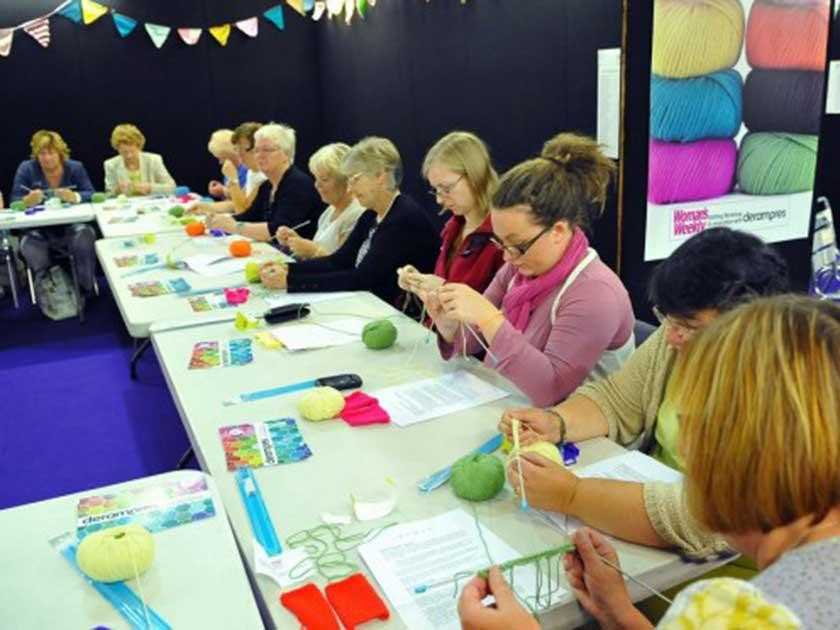Knitting abbreviations you need to know to knit
Print
Understanding knitting abbreviations is key to success with any pattern.
Some might seem very simple to decipher. To give an example, the most regularly used are either shortened versions of words (inc – increase or increasing) or letters describing what needs to be done next (psso – pass slipped stitch over).
Other knitting abbreviations, however, require a deeper level of knowledge. For instance, something like p2tog, might confuse a beginner.
If you feel stuck when working on a project, simply take a look at our helpful list of knitting terminology. Keep a note of the url for easy reference.
Below we list the most common knitting abbreviations and their meaning in alphabetical order.
alt: Alternate - worked on every other row or stitch
beg: Begin or beginning – to start as specified or position to be worked at or from, measured from or marked
cont: Continue - carry on working
dec: Decrease or decreasing - by working 2 or more stitches together.
Instructions will state how many stitches are to be decreased and quite often will have a row or rows set out to show how the stitches should be decreased. If no specific instructions are given how to decrease, work as follows:
To dec 1 st – The right-hand needle is inserted knitwise or purlwise in next 2 stitches on left-hand needle at the same time and complete as if knitting or purling 1 stitch, thus making 1 stitch out of 2.
To dec 2 sts – The right-hand needle is inserted knitwise or purlwise in next 3 stitches on left-hand needle at the same time and complete as if knitting or purling 1 stitch, thus making 1 stitches out of 3.
If more stitches need to be decreased – insert needle into number of stitches to be decreased plus one more and complete as above.
foll: Following
gst: Garter stitch – knit every stitch on every row. (Also refers to texture of fabric produced by knitting every stitch.)
inc: Increase or increasing - by working twice or more times into same stitch.
Instructions will state how many stitches to increase and quite often will have row or rows set out to how the stitches should be increased. If no specific instructions are given, work as follows:
To inc 1 st – Knit or purl in next stitch, but do not drop this stitch off left needle, work into back of stitch again, then drop this stitch off left needle.
To inc 2 or more sts – Keep working into back and front of stitch until required number of stitches are increased (the number of times worked into a stitch would be the number of stitches increased, plus first original stitch).
k: Knit
k st - With yarn at back, insert point of right-hand needle in front of stitch from left to right on left-hand needle, bring yarn under and over the top of point of right needle, draw loop through stitch and drop this stitch off left needle.
k row or rows – Knit ever stitch across each row until required number of rows have been worked.
m1: Make one – with point of left needle pick up horizontal loop lying between stitch just worked and next stitch and knit or purl into the back of it.
p: Purl
p st- With yarn at front, insert point of right hand needle in front of stitch from right to left on left needle, bring yarn over and under the top of point of right needle, draw loop through stitch and drop this stitch off left needle.
p row or rows – Purl ever stitch across each row until required number of rows have been worked.
patt: Pattern – texture of fabric created by stitches as set out on stated rows. (Also means, continue working or maintaining working stitches as set out before.)
psso: Pass slipped stitch over –insert point of left needle into front of slipped stitch (second stitch) on right needle, lift this stitch and place over first stitch on right needle.
p2sso: Pass 2 slipped stitch over –insert point of left needle into front of first then second slipped stitches on right needle, lift these stitches and place over first stitch on right needle.
rem: Remain or remaining
rep: Repeat
RS: Right side
skpo: Slip 1, knit 1, pass slipped stitch over
sl: Slip
sl 1 – Insert point of right needle in front knit wise (from left to right) or purl wise from (right to left) of next stitch on left needle and slip this stitch off left needle without working into it.
sl 2 or more stitches – work in same way as sl1 until 2 or stated number of stitches have been slipped.
st(s): Stitch or stitches
stst: Stocking stitch – knit all stitches on right side rows and purl all stitches on wrong side rows. Also means the texture of fabric that is created by knitting and purling alternately to produce smooth surface on knit (right) side and ridged surface on purl (wrong) side.
tog: Together – work 2 or more stitches together at the same time
k2tog - Insert point of right hand needle in front of second stitch, then in front of first stitch on left-hand needle, bring yarn under and over the top of point of right-hand needle, draw loop through both stitches and drop them off left-hand needle.
p2tog - Insert point of right hand needle in front of first stitch, then in front of second stitch on left needle, bring yarn over and under the top of point of right-hand needle, draw loop through both stitches and drop them off left-hand needle.
k3tog or p3tog or more stitches – Work as k2tog or p2tog, but inserting needle through 3 or more stitches.
tbl: Through back of loop
k1tbl – With yarn at back, insert point of right-hand needle from right to left in back of stitch on left-hand needle, bring yarn under and over the top of point of right-hand needle, draw loop through stitch and drop this stitch off left-hand needle.
p1tbl – With yarn at front, insert point of right-hand needle from right to left in back of stitch on left-hand needle, bring yarn over and under the top of point of right-hand needle, draw loop through stitch and drop this stitch off left-hand needle.
ws: Wrong side
yf: Yarn forward is usually worked between 2 knit stitches – bring yarn between needles from back to front of work and over point of right needle to make a st.
yon: Yarn over needle is usually worked between purl and knit stitches – take yarn over point of right-hand needle to make a st.
yrn: Yarn round needle. When worked between 2 purl stitches – take yarn over and under point of right-hand needle, bringing it to front of work to make a st. Worked between knit and purl stitches – take yarn between needles from back to front, then over and under point of right-hand needle, bringing it to front of work to make a st.

